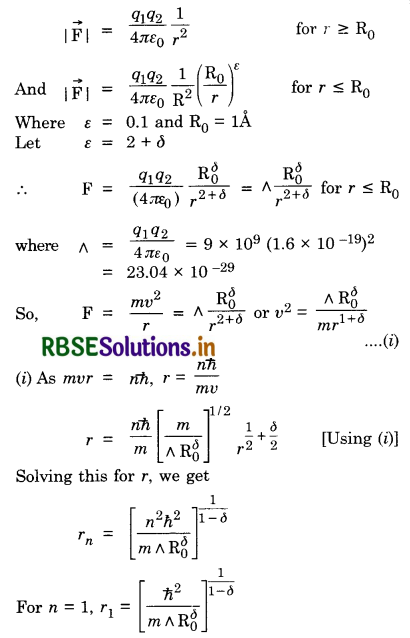RBSE Solutions for Class 12 Physics Chapter 12 Atoms
Rajasthan Board RBSE Solutions for Class 12 Physics Chapter 12 Atoms Textbook Exercise Questions and Answers.
RBSE Class 12 Physics Solutions Chapter 12 Atoms
RBSE Class 12 Physics Atoms Textbook Questions and Answers
Question 12.1.
Choose the correct alternative from the clues given at the end of each statement:
(a) The size of the atom in Thomson’s model ............................ is the atomic size in Rutherford’s model. (much greater than, not different from, much less than).
(b) In the ground state of ............................ electrons are in the stable equilibrium, while in ............................ electrons always experience a net force (Thomson’s model, Rutherford’s model).
(c) A classical atom based on ............................ is doomed to collapse. (Thomson’s model, Rutherford’s model)
(d) An atom has nearly continuous mass distribution in a ............................ but has a highly non-uniform mass distribution in ............................ (Thomson’s model, Rutherford’s model).
(e) The positively charged part of the atom possesses most of the mass in ............................ (Rutherford’s model, both the models).
Answer:
(a) Not different from
(b) Thomson’s model. Rutherford model
(c) Rutherford’s model
(d) Thomson’s model, Rutherford's model
(e) both the models.

Question 12.2.
Suppose you are given a chance to repeat the alpha-particle scattering experiment using a thin sheet of solid hydrogen in place of the gold foil. (Hydrogen is a solid at temperatures below 14 K). What result do you expect?
Answer:
The nucleus of a hydrogen atom is a proton. The mass of a proton is 1.67 x 10-27 kg, whereas the mass of an incident α-particle is 6.64 x 10-27 kg. Because the scattering part is more massive than the target nuclei (proton), the α-particle won’t bounce back in even a head-on collision. It is similar to a football colliding with a tennis ball at rest. Thus there would be no large-angle scattering.
Question 12.3.
What is the shortest wavelength present in the Paschen series of spectral lines?
Answer:
Since, \(\frac{1}{\lambda}=\mathrm{R}_{\mathrm{H}}\left[\frac{1}{n_1^2}-\frac{1}{n_2^2}\right]\)
For Paschen series, n1 = 3 and n2 = ∞
∴ \(\frac{1}{\lambda}=\mathrm{R}_{\mathrm{H}}\left[\frac{1}{3^2}-\frac{1}{\infty}\right]=\frac{\mathrm{R}_{\mathrm{H}}}{9}\)
or λ = \(\frac{9}{R_H}=\frac{9}{1.097 \times 10^7}\)
= 8.2 x 107 m
= 820 nm
Question 12.4.
A difference of 2.3 eV separates two energy levels in an atom. What is the frequency of radiation emitted when the atom makes a transition from the upper level to the lower level?
Answer:
Given E2 - E1 = 2.3 eV
or E2 - E1 = 2.3 x 1.6 x 10-19 J
v =?
Since v = \(\frac{\mathrm{E}_2-\mathrm{E}_1}{h}\)
= \(\frac{2.3 \times 1.6 \times 10^{-19}}{6.62 \times 10^{-34}}\)
= 5.6 x 1014 Hz.

Question 12.5.
The ground state energy of the hydrogen atom is -13.6 eV. What are the kinetic and potential energies of the electron in this state?
Answer:
K.E. of electron = \(\frac{k \mathrm{Z} e^2}{r}\)
P.E. of electron = -\(\frac{k \mathrm{Z} e^2}{r}\)
∴ PE = - 2(K.E.)
Since total energy
E = K.E. + P.E.
= K.E. - 2(K.E.)
= -K.E.
Given E = 13.6 V
∴ K.E. = -E = -(-13.6)
= 13.6 eV
PE = -2(K.E) = -2 x 13.6
= -27.2 eV.
Question 12.6.
A hydrogen atom initially in the ground level absorbs a photon, which excites it to the n = 4 level. Determine the wavelength and frequency of the photon.
Answer:
The energy of electron in nth state of hydrogen atom is given by:
En = -\(\frac{13.6}{n^2}\)
So energies in 1st and 4th states will be:
E1 = -13.6 eV and E4 = -\(\frac{13.6}{4^2}\) = -0.85 eV
∴ Energy absorbed during excitation
E = E4 - E1 = -0.85 + 13.6
= 12.75 eV
or hv = 12.75 eV = 12.75 x 1.6 x 10-9 J
∴ v = \(\frac{12.75 \times 1.6 \times 10^{-19}}{6.62 \times 10^{-34}}\)
= 3.0815 x 1015 Hz
= 3.1 x 1015 Hz
Since wavelength λ = \(\frac{c}{v}=\frac{3 \times 10^8}{3.0815 \times 10^{15}}\)
= 973.5 x 10-10 m = 973.5 Å
= 9.7 x 10-8 m
Question 12.7.
(a) Using Bohr’s model, calculate the speed of the electron in a hydrogen atom in the n = 1, 2 and 3 levels
(b) Calculate the orbital period in each of these levels,
Answer:
(a) The velocity of electron in nth orbit in an atom is given by:
vn = \(\frac{\mathrm{Ze}^2}{2 \varepsilon_0 n h}\)
For hydrogen Z = 1
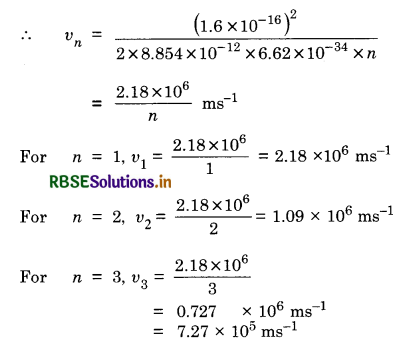
(b) Since time period in nth orbit is given by:

= n3 1542.37 x 1019 s-1
= n3 1.538116 x 10-16 s
For n = 1,
T1 = 13 x 1.5 x 10-16 s
= 1.538 x 10-16 s
For n = 2,
T2 = 8 x 1.5 x 10-16 s
or T2 = 12.0 x 10-16 s
For n = 3,
T3 = 27 x 1.5 x 10-16 s
= 40.5 x 10-16 s.
Question 12.8.
The radius of the innermost electron orbit of a hydrogen atom is 5.3 x 10-11 m. What are the radii of the n = 2 and n = 3 orbits?
Answer:
Given r1 = 5.3 x 10-11 m
n1 = 1
n2 = 2, r2 =?
n3 = 3, r3 =?
Since r ∝ n2
∴ r1 ∝ n12
And r2 ∝ n22
∴ \(\frac{r_2}{r_1}=\frac{n_2^2}{n_1^2}=\frac{2^2}{1}=\frac{4}{1}\)
or r2 = 4 x r1 = 4 x 5.3 x 10-11
or r2 = 2.12 x 10-10 m
Also r3 ∝ n32
∴ \(\frac{r_3}{r_1}=\frac{n_3^2}{n_1^2}=\frac{3^2}{1}=\frac{9}{1}\)
or r3 = 9r1 = 9 x 5.3 x 10-11
or r3 = 4.77 x 10-10 m.

Question 12.9.
A 12.5 eV electron beam is used to bombard gaseous hydrogen at room temperature. What series wavelength will be emitted?
Answer:
First excitation energy
E = E2 - E1 = -3.4 - (- 13.6)
= 10.2 eV
Second excitation energy
E = E3 - E1 = - 1.51 - (-13.6)
= 12.09 eV
Third excitation energy
E = E4 - E1 = - 0.85 - (- 13.6)
= 12.75 eV
Since the incident beam has energy = 12.5 eV
So only first two lines in the Lyman series of wave-length 103 nm and 122 nm will be emitted.
Also E3 - E2 = - 1.51 - (- 3.4) = 4.91 eV
i.e. first line in the Balmer series of wavelength 656 nm will also be emitted.
Question 12.10.
In accordance with Bohr’s model, find the quantum number that characterizes the earth’s revolution around the sun in an orbit of radius 1.5 x 1011 m with orbital speed 3 x 104 ms-1. (Mass of earth = 6.0 x 1024 kg).
Answer:
Here r = 1.5 x 1011 m,
v = 3 x 104 ms-1,
m = 6 x 1024 kg,
n =?

ADDITIONAL EXERCISES
Question 12.11.
Answer the following questions which help you to understand the difference between Thomson’s model and Rutherford’s model better.
(a) Is the average angle of deflection of α-particles by a thin gold foil predicted by Thomson’s model much less, about the same, or much greater than that predicted by Rutherford’s model?
(b) Is the probability of backward scattering (i.e., scattering of α-particles at angle greater than 90°) predicted by Thomson’s model much less, about the same, or much greater than that predicted by Rutherford’s model?
(c) Keeping other factors fixed, it is found experimentally that for a small thickness t, the number of α-particles scattered at moderate angles is proportional to t. What clue does this linear dependence on t provide?
(d) In which model is it completely wrong to ignore multiple scattering for the calculation of average angle of scattering of α-particles by a thin foil?
Answer:
(a) About the same
(b) Much less
(c) It suggests that scattering is predominantly due to a single collision, because the chance of a single collision increases linearly with the number of the target atoms, and hence linearly with the thickness of the foil.
(d) In Thomson’s model, a single collision causes a very little deflection. The observed average scattering angle can be explained only by considering multiple scattering. So it is wrong to ignore multiple scattering in Thomson’s model. However, in Rutherford’s model, most of the scattering comes through a single collision and multiple scattering effects can be ignored as a first approximation.

Question 12.12.
The gravitational attraction between electron and proton in a hydrogen atom is weaker than the Coulomb attraction by a factor of about 10-40. An alternative way of looking at this fact is to estimate the radius of the first Bohr orbit of hydrogen atom if the electron and proton were bound by gravitational attraction. You will find the answer interesting.
Answer:
If electron and proton were bounded by gravitational attraction, then
F = G\(\frac{m_e m_p}{r^2}\)
This force provides necessary centripetal force
F = \(\frac{m_e v^2}{r}\)
∴ \(\frac{m_e v^2}{r}=\frac{\mathrm{G} m_e m_p}{r^2}\)
or mev2 r = G memp ........................(i)
From Bohr's condition
mevr = \(\frac{n h}{2 \pi}\)
or me2 v2 r2 = \(\frac{n^2 h^2}{4 \pi^2}\) .........................(ii)
Dividing Eq. (ii) by (i) we get
mer = \(\frac{n^2 h^2}{4 \pi^2 \mathrm{G} m_e^2 m_p}\)
or r = \(\frac{n^2 h^2}{4 \pi^2 \mathrm{G} m_e^2 m_p}\)
For 1st orbit n = 1
So
r1 = \(\frac{1 \times\left(6.62 \times 10^{-34}\right)^2}{4 \times 9.87 \times 6.67 \times 10^{-11} \times\left(9.1 \times 10^{-31}\right)^2 \times 1.67 \times 10^{-27}}\)
or r1 = 1.21 x 1029 m
This is much greater than the estimated size of the whole universe.
Question 12.13.
Obtain an expression for the frequency of the radiation emitted when a hydrogen atom de-excites from level n to level (n = 1). For large n, show that this frequency equals the classical frequency of revolution of the electron in the orbit.
Answer:
We know that

Orbit frequency vc = \(\frac{v}{2 \pi r}\)
Now in Bohr's model,

which is the same as v for large n.
Question 12.14.
Classically, an electron can be in any orbit around the nucleus of an atom. Then what determines the typical atomic size? Why is an atom not, say, thousand times bigger than its typical size? The question has greatly puzzled Bohr before he arrived at his famous model of the atom that you have learned in the text. To stimulate what he might well have done before his discovery, let us play as follows with the basic constants of nature and see if we can get a quantity with the dimensions of length that is roughly equal to the known size of an atom (~10-10 m).
(a) Construct a quantity with the dimension of length from the fundamental constants, e, me and c. Determine its numerical value.
(b) You will find that the length obtained in (a) is many orders of magnitude smaller than the atomic dimensions. Further, it involves c. But energies of atoms are mostly in non-relativistic domain where c is not expected to play any role. This is what may have suggested Bohr to discard c and look for something else to get the right atomic size. Now, the Planck’s constant h had already made its appearance elsewhere. Bohr’s great insight lay in recognizing that h, me and e will yield the right atomic size, Construct a quantity with the dimension of length from h me and e and confirm that its numerical value has indeed the correct order of magnitude.
Answer:
(a) Coulomb’s force between hydrogen nucleus and electron
Fr = \(\frac{1}{4 \pi \varepsilon_0} \frac{e}{r^2}\) x e
r = \(\frac{e^2}{4 \pi \varepsilon_0 \mathrm{~F}_r}\)
Fr = force x distance = work done = mc2
r = \(\frac{e^2}{4 \pi \varepsilon_0 \times m c^2}\)
= 2.81 x 10-15 m
It is much smaller than typical atomic size.
(b) The quantity \(\frac{4 \pi \varepsilon_0 h^2}{m e^2}\) has the dimension of length. Its value is 0.53 x 10-10 m of the order of atomic sizes.

Question 12.15.
The total energy of an electron in the first excited state of the hydrogen atom is about -3.4 eV.
(а) What is the kinetic energy of the electron in this state?
(b) What is the potential energy of the electron in this state?
(c) Which of the answers above would change if the choice of the zero of potential energy is changed?
Answer:
In Bohr’s model,

These relations have nothing to do with the choice of the zero of potential energy. Now, choosing the zero of potential energy at infinity we have
V = -\(\frac{\mathrm{Z} e^2}{4 \pi \varepsilon_0 r}\) which gives
V = -2T
and E = T + V = -T
(a) The quoted value of E = - 3.4 eV is based on the customary choice of zero of potential energy at infinity. Using E = -T, the kinetic energy of the electron in the state is +3.4 eV.
(b) Using V = -2T, potential energy of the electron is = -68 eV.
(c) If the zero of potential energy is chosen differently, kinetic energy does not change. Its value is +3.4 eV independent of the choice of the zero of potential energy. The potential energy and the total energy is chosen.
Question 12.16.
If Bohr’s quantization postulate (angular momentum = nh/2π) is a basic law of nature, it should be equally valid for the case of planetary motion also. Why then do we never speak of quantization of orbits of planets around the sun?
Answer:
Angular momenta associated with planetary motion are large relative to h. For example, angular momentum of the earth in its orbital motion is of the order to 107 h. In terms of the Bohr’s quantization postulate his corresponds to very large value of h (of the order of 1070). For such large values of h, the differences in the successive energies and angular momenta of the quantized levels of the Bohr model are so small compared to the energies and angular moments respectively of the levels that one can, for all practical purpose, consider the level continuous.
Question 12.17.
Obtain the first Bohr radius and the ground state energy of a ‘muonic hydrogen atom’ (i.e. an atom in which a negatively charged moun (µ-) of mass about 207 me orbits around a proton.
Answer:
r0 = 0.53 x 10-10 m;
(E1) = 13.6 eV;
mµ = 207 me; rµ =?; (E1) =?

SELECTED EXEMPLAR PROBLEMS
MCQ I [with one correct option]
Question 12.1.
Taking the Bohr radius as a0 = 53 pm, the radius of Li++ ion in its ground state, on the basis of Bohr’s model, will be about
(a) 53 pm
(b) 27 pm
(c) 18 pm
(d) 13 pm.
Answer:
(c)
From Bohr’s model
r = \(\frac{n^2 h^2 4 \pi \varepsilon_0}{4 \pi^2 m e^2 Z}\) = r0 \(\frac{n^2}{Z}\)
For Li+++, Z = 3, n = 1 for ground state and r0 = 0.53 Å = 0.53 x 10-10 = 53 x 10-12 m = 53 pm
∴ r = \(\frac{53 \times 1^2}{3}\) = 18 pm

Question 12.2.
The binding energy of an H-atom, considering an electron moving around a fixed nucleus (proton), is B = -\(\frac{m e^4}{8 n^2 \varepsilon_0^2 h^2}\) (m = electron mass.)
If one decides to work in a frame of reference where the electron is at rest, the proton would be moving around it. By similar arguments, the binding energy would be
B = -\(\frac{\mathrm{M} e^4}{8 n^2 \varepsilon_0^2 h^2}\) (M = proton mass)
This last expression is not correct because
(a) n would not be integral
(b) Bohr-quantisation applies only to electron
(c) the frame in which the electron is at rest is not inertial
(d) the motion of the proton would not be in circular orbits, even approximately.
Answer:
(c) The frame in which the electron is at rest is the non-inertial frame.
Question 12.3.
The simple Bohr model cannot be directly applied to calculate the energy levels of an atom with many electrons. This is because
(a) of the electrons not being subject to a central force
(b) of the electrons colliding with each other
(c) of screening effects
(d) the force between the nucleus and an electron will no longer be given by Coulomb’s law.
Answer:
(a) Because electrons are not being subject to a central force.
Question 12.4.
For the ground state, the electron in the H-atom has an angular momentum = h, according to the simple Bohr model. Angular momentum is a vector and hence there will be infinitely many orbits with the vector pointing in all possible directions. Actuality, this is not true,
(а) because Bohr model gives incorrect values of angular momentum
(b) because only one of these would have a minimum energy
(c) angular momentum must be in the direction of spin of electron
(d) because electrons go around only in horizontal orbits.
Answer:
(a) because Bohr model gives incorrect values of angular momentum.
Question 12.5.
O2 molecule consists of two oxygen atoms. In the molecule, nuclear force between the nuclei of the two atoms
(a) is not important because nuclear forces are short-ranged
(b) is as important as electrostatic force for binding the two atoms
(c) cancels the repulsive electrostatic force between the nuclei
(d) is not important because oxygen nuclei have equal number of neutrons and protons.
Answer:
(a) Because nuclear forces are short-ranged.
Question 12.6.
Two H atoms in the ground state collide inelastically. The maximum amount by which their combined kinetic energy is reduced by
(a) 10.20. eV
(b) 20.40 eV
(c) 13.6 eV
(d) 27.2 eV.
Answer:
(a)
Initial K.E. of both hydrogen atom in ground state = 2 x 13.6 = 27.2 eV.
Since the collision is inelastic, so some K.E. is lost. If one hydrogen atom goes to first excited state and other remains in ground state combined K.E. after
collision = \(\frac{13.6}{2^2}+\frac{13.6}{1^2}\) = 17.0 eV
∴ Maximum loss of their K.E. = 27.2 - 17.0 = 10.2 eV.

Question 12.7.
A set of atoms in an excited state decays
(a) in general to any of the states with lower energy
(b) into a lower state only when excited by an external electric field
(c) all together simultaneously into a lower state
(d) to emit protons only when they collide.
Answer:
(a) A set of atoms in an excited state can decay to any of the states with lower energy.
MCQ II. (with more than one correct options)
Question 12.8.
An ionized H-molecule consists of an electron and two protons. The protons are separated by a small distance of the order of angstrom. In the ground state
(a) the electron would not move in circular orbits
(b) the energy would be (2)4 times that of a H-atom
(c) the electrons, orbit would go around the protons
(d) the molecule will soon decay in a proton and a H-atom.
Answer:
(a), (c) In ground state the electron would not move in circular orbits and the electrons orbit would go around the protons.
Question 12.9.
Consider aiming a beam of free electrons towards free protons. When they scatter, an electron and a proton cannot combine to produce an H-atom,
(a) because of energy conservation
(b) without simultaneously releasing energy in the form of radiation
(c) because of momentum conservation
(d) because of angular momentum conservation.
Answer:
(a), (b) Electron and proton can scatter but cannot combine to produce an H-atom due to energy conservation and without simultaneously releasing energy in the form of radiation.
Question 12.10.
The Bohr model for the spectra of an H-atom
(a) will not be applicable to hydrogen in the molecular form
(b) will not be applicable as it is for a He-atom
(c) is valid only at room temperature
(d) predicts continuous as well as discrete spectral lines.
Answer:
(a), (b) These are the limitations of Bohr’s model.
Question 12.11.
The Balmer series for the H-atom can be observed
(а) if we measure the frequencies of light emitted when an excited atom falls to the ground state
(b) if we measure the frequencies of light emitted due to transitions between excited states and the first excited state
(c) in any transition in an H-atom
(d) as a sequence of frequencies with the higher frequencies getting closely packed.
Answer:
(b), (d) In Balmer series, we measure the frequencies of light due to transition between excited states and the first excited state and as a sequence of frequencies with the higher frequencies getting closely packed.
Question 12.12.
Let En = \(\frac{-1}{8 \varepsilon_0^2} \frac{m e^4}{n^2 h^2}\) be the energy of the nth level of H-atom. If all the H-atoms are in the ground state and radiation of frequency (E2 -E1)/h falls on it
(а) it will not be absorbed at all
(b) some of atoms will move to the first excited state
(c) all atoms will be excited to the n = 2 state
(d) no atoms will make a transition to the n = 3 state.
Answer:
(b), (d) The energy of incident radiation will move some atoms to 1st excited state and no atom can make transition to n = 3 state as energy is not sufficient to take atoms to n = 3.

Question 12.13.
The simple Bohr model is not applicable to He4 atom because
(a) He4 is an inert gas
(b) He4 has neutrons in the nucleus
(c) He4 has one more electron
(d) electrons are not subjected to central forces.
Answer:
(c), (d)
Bohr model applies only to one electron atom (H-atom).
Very Short Answer Type Questions
Question 12.14.
The mass of an H-atom is less than the sum of the masses of a proton and electron. Why is this?
Answer:
When H-atom is formed from a proton and a neutron, some mass is converted into energy according to the formula
mp + mc -\(\frac{\mathrm{B}}{c^2}\) (B = 13.6 eV is the binding energy)
Question 12.15.
Imagine removing one electron from He4 and He3. Their energy levels, as worked out on the basis of Bohr model will be very close. Explain Why.
Answer:
Because both the nuclei are very heavy as compared to electron mass.
Question 12.16.
When an electron falls from a higher energy to a lower energy level, the difference in the energies appears in the form of electromagnetic radiation. Why cannot it be emitted as other forms of energy?
Answer:
The difference in energy appears in the form of e.m. radiation because the electrons interact electromagnetically only.
Question 12.17.
Would the Bohr formula for the H-atom remain unchanged if proton had a charge (+4/3)e and electron a charge (-3/4)e, where e = 1.6 x 10-19 C. Give reasons for your answer.
Answer:
Yes. As Bohr formula involves only the product of charges, so its value will change.

Question 12.18.
Consider two different hydrogen atoms. The electron in each atom is in an excited state. Is it possible for the electrons to have different energies but the same orbital angular momentum according to the Bohr model?
Answer:
No, because En = -\(\frac{13.6}{n^2}\) and mvr = \(\frac{n h}{2 \pi}\).
Electrons having different energies belong to different levels having different value of n, hence angular momentum will also be different.
Short Answer Type Questions
Question 12.19.
Positronium is just like a H-atom with the proton replaced by the positively charged anti-particle of the electron (called the positron which is as massive as the electron). What would be the ground state energy of positronium?
Answer:
In Bohr’s formula
En = \(\frac{-m e^4}{8 \varepsilon_0^2 n^2 h^2}\)
For ground state n = 1.
So En = -\(\frac{m e^4}{8 \varepsilon_0^2 h^2}\)
For H-atom m = me (En becomes En = -13.6 eV)
For positron, reduced mass
µ = \(\frac{m_e \cdot m_e}{\left(m_e+m_e\right)}=\frac{m_e}{2}\)
So En = -\(\frac{13.6}{2}\) = - 6.8 eV
Question 12.20.
Assume that there is no repulsive force between the electrons in an atom but the force between positive and negative charges is given by Coulomb’s law as usual. Under such circumstances, calculate the ground state energy of a He-atom.
Answer:
In He atom two electrons of charge (-2e) revolve around the nucleus.
And En = -\(\frac{m e^2 \mathrm{Z}^2}{8 \varepsilon_0^2 n^2 h^2}\) = 4E [Z = 22 = 4]
∴ Ground state energy
= 4 x E = 4 x (- 13.6) = - 54.4 eV
Question 12.21.
Using Bohr model, calculate the electric current created by the electron when the H-atom is in the ground state.
Answer:
If r0 is Bohr radius and v0 is the velocity of electron in 1st orbit, then
Time period T = \(\frac{2 \pi r_0}{v_0}\)
So I = \(\frac{e}{\mathrm{~T}}=\frac{e v_0}{2 \pi r_0}\)
Question 12.22.
Show that the first few frequencies of light that is emitted when electrons fall to the nth level from levels higher than n, are approximate harmonics (i.e. in the ratio 1:2:3) when n >> 1.
Answer:
When an electron jumps from (n + p) orbit p = 1, 2,............. to nth orbit, the frequency of radiation emitted is given by

So first few frequencies are approximately harmonics i.e. in the order of 1, 2, 3,..............

Question 12.23.
What is the minimum energy that must be given to an H-atom in ground state so that it can emit an Hγ line in Balmer series. If the angular momentum of the system is conserved, what would be the angular momentum of such Hγ photon?
Answer:
Balmer series of Hγ require transition from n = 5 to n = 1
So energy required to excite electron from n = 1 to n = 5 is
E = E1 - E5 = 13.6 - 0.54 = 13.06 eV
If angular momentum is conserved, then angular momentum of photon
= L5 - L2 = 5\(\hbar\) - 2\(\hbar\) = 3\(\hbar\)
= 3 x 1.06 x 10-34 kg m2s -1
= 3.18 x 10-34 kg m2s-1
Long Answer Type Questions
Question 12.26.
If a proton had a radius R and the charge was uniformly distributed, calculate using Bohr theory, the ground state energy of an H-atom when (i) R = 0.1 Å, and (ii) R = 10 Å.
Answer:
For a point nucleus in H-atom Ground state
\(\frac{m v^2}{r_{\mathrm{B}}}=\frac{1}{4 \pi \varepsilon_0} \frac{e^2}{r_{\mathrm{B}}^2} and v = \frac{\hbar}{m r_{\mathrm{B}}}\)
By Bohr’s postulates in ground state, we have on solving,
∴ m\(\frac{\hbar^2}{m^2 r_{\mathrm{B}}^2} \cdot \frac{1}{r_{\mathrm{B}}}=+\left(\frac{e^2}{4 \pi \varepsilon_0}\right) \frac{1}{r_{\mathrm{B}}^2}\)
∴ \(\frac{\hbar^2}{m} \cdot \frac{4 \pi \varepsilon_0}{e^2}\) = rB = 0.51 Å [This is Bohr's radius] (i)
The potential energy is given by
P.E. = -\(\left(\frac{e^2}{4 \pi r_0}\right) \cdot \frac{1}{r_{\mathrm{B}}}\) = -27.2 eV
K.E. = \(\frac{1}{2} m v^2=\frac{1}{2} m \cdot \frac{\hbar^2}{m^2 r_{\mathrm{B}}^2}=\frac{\hbar^2}{2 m r_{\mathrm{B}}^2}\) = +13.6 eV
Now, for a spherical nucleus of radius R,
If R < rB, The same result,
If R >> rB the electron moves inside the sphere with radius r'B (r'B = new Bohr radius).
Charge inside e' = e\(\left(\frac{r_{\mathrm{B}}^3}{\mathrm{R}^3}\right)\)
using eq. (i)
∴ rB' = \(\frac{\hbar^2}{m}\left(\frac{4 \pi \varepsilon_0}{e^{\prime 2}}\right)=\frac{\hbar^2}{m} \frac{4 \pi \varepsilon_0}{e\left(r_{\mathrm{B}}^{\prime 3}\right)^2}\left(\mathrm{R}^3\right)^2\)
r'B4 = (0.51 Å). R3 [∵ R = 10 Å]
= 510 (Å)4
∴ rB' = (510)1/4 Å < R
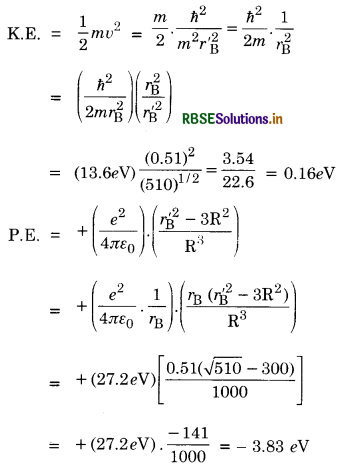
Question 12.27.
In the Auger process an atom makes a transition to a lower state without emitting a photon. The excess energy is transferred to an outer electron which may be ejected by the atom. (This is called an Auger electron). Assuming the nucleus to be massive, calculate the kinetic energy of an n = 4 Auger electron emitted by Chromium by absorbing the energy from a n = 2 to n = 1 transition.
Answer:
As the nucleus is massive, recoil momentum of the atom may be neglected and the entire energy of the transition may be considered transferred to the Auger electron. As there is a single valence electron in Cr, the energy states may be thought of as given by the Bohr model.
The energy of the nth state
En =- Z2R\(\frac{1}{n^2}\) where R is the Rydberg constant and Z = 24
In transition from n = 2 to n = 1,
Energy released
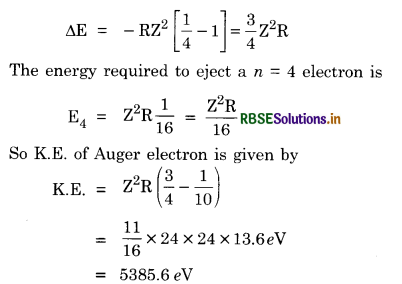

Question 12.28.
The Bohr model for the H-atom relies on the Coulomb’s law of electrostatics. Coulomb’s law has not directly been verified for very short distances of the order of angstroms. Supposing Coulomb’s law between two opposite charge +q1, -q2 is modified to
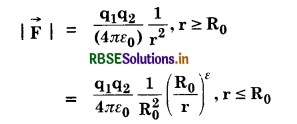
Calculate in such a case, the ground state energy of an H-atom, if ε = 0.1, R0 = 1 Å.
Answer:
We have:
